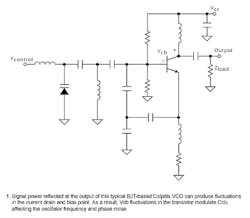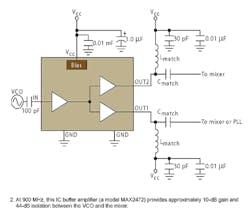This file type includes high resolution graphics and schematics when applicable.
Isolation between two circuit stages is often achieved by introducing a buffer amplifier between them. This isolation minimizes adverse effects in a wide range of applications, and especially for those using RF signals. Poor output isolation can produce various mechanisms that disturb oscillator performance, so a buffer stage is often included at oscillator outputs. In discussing these uses for buffer amplifiers, this article focuses on a voltage-controlled oscillator (VCO) whose active device is an NPN bipolar transistor. The resulting applications generally operate with other active devices as well.
Before discussing the addition of a buffer-amplifier stage, consider some typical VCO characteristics and how isolation problems can degrade performance. A common problem, for example, is the frequency change exhibited by a VCO in response to varying load conditions (frequency pulling). A change in impedance seen by the VCO output can induce changes in the DC voltages across junctions of the VCO's active device. A change in the collector-to-base voltage (Vcb) of a bipolar device, for instance, affects the collector-to-base capacitance (Ccb), which in turn can alter the oscillation frequency by affecting the overall tank resonance (Fig. 1).
Another frequency-pulling phenomenon is sometimes referred to as injection locking or injection pulling. It concerns the effect of an interfering signal that is very near the VCO's operating frequency. When an interferer's amplitude at the VCO output port is sufficient, it can cause the VCO to shift its oscillation frequency to match the interfering frequency.1 Another key performance factor affected by poor output isolation is phase noise. Much research has been done in the last few years to better describe the generation of phase noise in oscillators. Conditions that produce phase noise include changes in load impedance, power reflections back to the VCO output, excessive ground current, and radiated coupling due to poor RF layout. The induced voltage changes can cause bias-current fluctuations in the active device, a modulating effect on Ccb, perturbations in amplitude, and other subtle problems that degrade performance.2
Adequate VCO isolation also depends on board layout, and whether the VCO is discrete, integrated, or modular. VCO operation can be disturbed by any radiated RF energy coupled to the VCO. The energy can be coupled directly to the VCO or through other circuits or traces connected to the VCO. Even unconnected circuit traces running near the VCO can serve as antennas. Proper layout should always be observed when VCO noise performance is critical.
One cause of conducted degradation can be the RF power amplifier (PA) turning on or off, which can cause an impedance change in the signal path or in other circuits, thereby picking up radiated RF energy and conducting it back through the signal path. Good printed-circuit-board (PCB) layout helps to minimize radiated and conducted perturbations of the VCO. Grounding, shielding, and the routing of traces near the VCO can affect VCO operation, as well as the amount of isolation the VCO buffer circuit can achieve.
It is also important to understand how these degradation mechanisms manifest themselves during radio operation. Poor output isolation can degrade the phase-locked-loop (PLL) lock time when a reflected signal reaches the VCO. It may be necessary to isolate the phase-detector input from the receiver (Rx) or transmitter (Tx) to alleviate this problem. High phase noise can also degrade the adjacent-channel protection in either transmit or receive mode. Poor VCO isolation can also result in modulation distortion during transmit operation.
Resolving a radiated-interference problem often requires experimentation, but a conducted-interference problem can often be resolved by simply adding a VCO buffer amplifier. An integrated buffer such as the MAX2472 is small and provides excellent isolation of the VCO. Its circuit topology is suitable for providing the local oscillator (LO) and phase-detector input signals, while maintaining isolation between them and the VCO.
Analysis of the scattering (S)-parameters in the table3 show that the MAX2472 can improve poor VCO output isolation (Fig. 2).
The typical isolation achieved between VCO and mixer is approximately 44 dB at 900 MHz and 30 dB at 1900 MHz. The device provides highly stable gains at those frequencies, of 10 and 8 dB, respectively.
The MAX2473 integrated-circuit (IC) amplifier makes a good VCO buffer when there is only one signal path at the VCO output. As an added feature, its adjustable bias current minimizes current drain in portable applications.
Some VCO isolation problems require extensive analysis, and others are easily overcome. Small, integrated VCO buffers such as the MAX2472/MAX2473 can provide the simple solutions for VCO problems.
REFERENCES
- B. Razavi, RF Microelectronics, Prentice-Hall, Englewood Cliffs, NJ, 1998, pp. 225-226.
- T.H. Lee and A. Hajimiri, "Oscillator Phase Noise: A Tutorial," IEEE Journal of Solid-State Circuits, Vol. 35, March 2000.
- MAX2472/MAX2473 datasheet, Maxim Integrated Products, Sunnyvale, CA. The latest version is available at www.maxim-ic.com.
This file type includes high resolution graphics and schematics when applicable.




